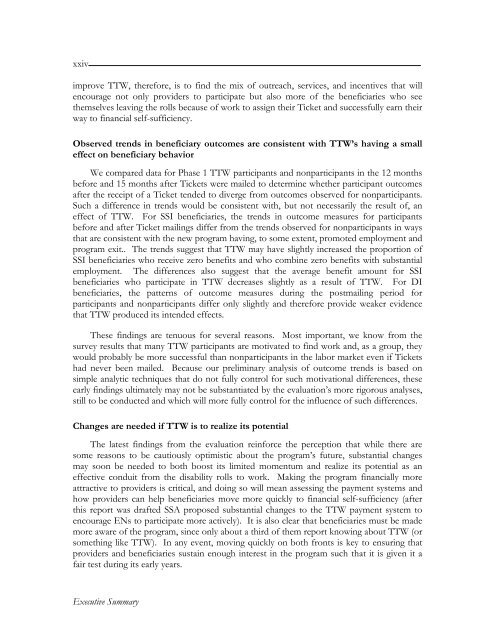Evaluation of the Ticket to Work Program, Implementation ...
Evaluation of the Ticket to Work Program, Implementation ...
Evaluation of the Ticket to Work Program, Implementation ...
You also want an ePaper? Increase the reach of your titles
YUMPU automatically turns print PDFs into web optimized ePapers that Google loves.
xxivimprove TTW, <strong>the</strong>refore, is <strong>to</strong> find <strong>the</strong> mix <strong>of</strong> outreach, services, and incentives that willencourage not only providers <strong>to</strong> participate but also more <strong>of</strong> <strong>the</strong> beneficiaries who see<strong>the</strong>mselves leaving <strong>the</strong> rolls because <strong>of</strong> work <strong>to</strong> assign <strong>the</strong>ir <strong>Ticket</strong> and successfully earn <strong>the</strong>irway <strong>to</strong> financial self-sufficiency.Observed trends in beneficiary outcomes are consistent with TTW’s having a smalleffect on beneficiary behaviorWe compared data for Phase 1 TTW participants and nonparticipants in <strong>the</strong> 12 monthsbefore and 15 months after <strong>Ticket</strong>s were mailed <strong>to</strong> determine whe<strong>the</strong>r participant outcomesafter <strong>the</strong> receipt <strong>of</strong> a <strong>Ticket</strong> tended <strong>to</strong> diverge from outcomes observed for nonparticipants.Such a difference in trends would be consistent with, but not necessarily <strong>the</strong> result <strong>of</strong>, aneffect <strong>of</strong> TTW. For SSI beneficiaries, <strong>the</strong> trends in outcome measures for participantsbefore and after <strong>Ticket</strong> mailings differ from <strong>the</strong> trends observed for nonparticipants in waysthat are consistent with <strong>the</strong> new program having, <strong>to</strong> some extent, promoted employment andprogram exit.. The trends suggest that TTW may have slightly increased <strong>the</strong> proportion <strong>of</strong>SSI beneficiaries who receive zero benefits and who combine zero benefits with substantialemployment. The differences also suggest that <strong>the</strong> average benefit amount for SSIbeneficiaries who participate in TTW decreases slightly as a result <strong>of</strong> TTW. For DIbeneficiaries, <strong>the</strong> patterns <strong>of</strong> outcome measures during <strong>the</strong> postmailing period forparticipants and nonparticipants differ only slightly and <strong>the</strong>refore provide weaker evidencethat TTW produced its intended effects.These findings are tenuous for several reasons. Most important, we know from <strong>the</strong>survey results that many TTW participants are motivated <strong>to</strong> find work and, as a group, <strong>the</strong>ywould probably be more successful than nonparticipants in <strong>the</strong> labor market even if <strong>Ticket</strong>shad never been mailed. Because our preliminary analysis <strong>of</strong> outcome trends is based onsimple analytic techniques that do not fully control for such motivational differences, <strong>the</strong>seearly findings ultimately may not be substantiated by <strong>the</strong> evaluation’s more rigorous analyses,still <strong>to</strong> be conducted and which will more fully control for <strong>the</strong> influence <strong>of</strong> such differences.Changes are needed if TTW is <strong>to</strong> realize its potentialThe latest findings from <strong>the</strong> evaluation reinforce <strong>the</strong> perception that while <strong>the</strong>re aresome reasons <strong>to</strong> be cautiously optimistic about <strong>the</strong> program’s future, substantial changesmay soon be needed <strong>to</strong> both boost its limited momentum and realize its potential as aneffective conduit from <strong>the</strong> disability rolls <strong>to</strong> work. Making <strong>the</strong> program financially moreattractive <strong>to</strong> providers is critical, and doing so will mean assessing <strong>the</strong> payment systems andhow providers can help beneficiaries move more quickly <strong>to</strong> financial self-sufficiency (afterthis report was drafted SSA proposed substantial changes <strong>to</strong> <strong>the</strong> TTW payment system <strong>to</strong>encourage ENs <strong>to</strong> participate more actively). It is also clear that beneficiaries must be mademore aware <strong>of</strong> <strong>the</strong> program, since only about a third <strong>of</strong> <strong>the</strong>m report knowing about TTW (orsomething like TTW). In any event, moving quickly on both fronts is key <strong>to</strong> ensuring thatproviders and beneficiaries sustain enough interest in <strong>the</strong> program such that it is given it afair test during its early years.Executive Summary
















